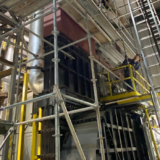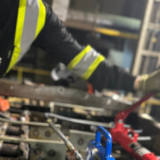Asset Maintenance Strategies for the Mining, Agriculture, and Industrial Sectors
In the vast and varied landscapes of mining, agriculture, and industrial sectors, the machinery and equipment stand as silent giants—crucial to production, yet constantly at the mercy of wear and tear. Asset maintenance in these fields is not just a matter of routine; it’s a pivotal part of sustaining operations, enhancing efficiency, and securing the bottom line. Dive into this exploration of how tailored asset maintenance strategies can safeguard the vitality of heavy industry.
Understanding Asset Maintenance in Heavy Industries
At its core, asset maintenance in heavy industries involves a systematic approach to keeping equipment operational, minimizing downtime, and preventing malfunctions before they occur. This is no small feat considering the harsh conditions and constant use typical in mining, agriculture, and industrial settings. From gigantic mining drills burrowing into the earth’s crust to agricultural machinery that plows fields day in and day out, each asset tells a story of endurance and the need for meticulous care.
The significance of asset maintenance transcends mere operational convenience; it directly impacts safety, productivity, and financial health. A well-oiled machine is a metaphor that holds literal truth in heavy industries – lubrication routines, for example, are a crucial part of maintenance activities that help in significantly reducing wear and tear.
Key Asset Maintenance Strategies for Effective Management
Effective management of assets hinges on adopting a strategic mix of corrective and preventive maintenance. While corrective actions are taken post-failure, preventive maintenance is all about foresight—periodic checks, replacing parts before they wear out, and staying ahead of potential breakdowns. As each sector has its rhythm and demands, customization of these strategies is crucial. It’s akin to crafting a bespoke suit; the better the fit, the greater the performance and longevity of the assets.
Furthermore, condition-based maintenance has emerged as a game-changer, especially with advancements in IoT technology. Sensors mounted on machinery can now predict failures before they happen, allowing for maintenance to be as timely as it is targeted.
The Role of Predictive Maintenance in Mining and Agriculture
Predictive maintenance transcends conventional maintenance paradigms by employing advanced data analytics and monitoring technologies to forecast when a piece of equipment might fail. This foresight allows businesses in mining and agriculture to plan maintenance activities during non-critical operational periods, essentially minimizing downtime and maintaining a steady flow of production. The key lies in data—collecting and analyzing it to understand equipment health in real-time.
Implementing a Preventive Maintenance Schedule in the Industrial Sector
In the rhythm of the industrial sector, where production lines and machinery are the heartbeat of operations, implementing a preventive maintenance schedule is paramount. It’s like setting a regular health check-up for machinery—catching issues before they escalate into serious problems. This proactive approach not only extends the life of assets but also aligns with lean manufacturing principles, optimizing efficiency and reducing waste.
Crafting a preventive maintenance schedule can be as intricate as it is vital. It involves detailed analysis of equipment performance, manufacturer recommendations, and historical maintenance data. The goal? To strike the perfect balance between over-maintenance, which can be costly, and under-maintenance, which can lead to failures.
Technological Innovations Enhancing Asset Maintenance
Technological innovations are redefining the landscape of asset maintenance. The advent of AI and machine learning algorithms has paved the way for predictive analytics, transforming data into actionable insights. Meanwhile, drones and robotics are being employed for inspections in environments that are hazardous for humans. These technological tools not only enhance the accuracy of maintenance tasks but also improve the safety and efficiency of operations.
Best Practices for Asset Lifecycle Management Across Sectors
Effective asset lifecycle management involves a holistic approach, focusing on optimizing the performance and extending the lifespan of assets from acquisition to disposal. Best practices in this domain include regular training for maintenance staff, investment in quality tools and technology, and a strong emphasis on data-driven decision-making. Understanding the lifecycle of each asset helps businesses make informed decisions about maintenance, replacement, and retirement, thus ensuring the best return on investment.
Overcoming Common Asset Maintenance Challenges
Common challenges in asset maintenance range from dealing with the unexpected breakdown of machinery to the skills gap in maintenance teams. Overcoming these obstacles requires a multifaceted approach, including investing in employee training, adopting flexible maintenance strategies, and leveraging technology for efficiency and insight. Addressing these challenges head-on is crucial for minimizing downtime and ensuring that operations run smoothly and safely.
Case Studies: Success Stories in Asset Maintenance
Examining real-world success stories offers valuable insights into effective asset maintenance. For instance, a mining operation that implemented a comprehensive predictive maintenance program saw a significant reduction in unplanned downtime, translating to increased productivity and profits. Similarly, an agricultural business that adopted drone technology for equipment inspection was able to identify issues early and make necessary repairs, thereby avoiding costly downtime during critical production periods.
Steering Through the Maintenance Maze
Navigating the intricacies of asset maintenance across the mining, agriculture, and industrial landscapes is akin to steering a ship through ever-changing seas. Each sector faces its unique challenges, but the underlying principle remains constant: proactive, strategic maintenance is key to longevity and profitability. By adopting innovative maintenance technologies, adhering to preventive schedules, and fostering a culture of continuous improvement, businesses can ensure their assets remain in prime condition, ready to face the demands of tomorrow.



